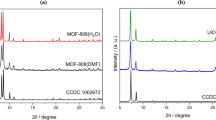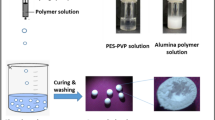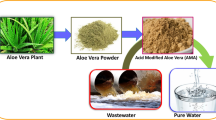Abstract
The silica gel functionalized tris(2-aminoethyl)amine moiety (SG-TAEA-NH2) has been successfully used for capturing aqueous uranium ion by batch sorption. Various sorption experiments are performed using several variables such as pH, initial concentration, contact time, and temperature. These variables enable us to study the thermodynamic and kinetic of sorption, which in turn, leads to know more about the interaction and behavior of the uranium ion on the surface. The equilibrium of sorption can be achieved within the first t = 5–10 min upon the study conditions (Ci = 1 mg L−1, T = 25 °C, 80 rpm, pHi = 7, and dosage = 2 g L−1). The sorption of U(IV) ion onto the surface of SG-TAEA-NH2 material. The sorption of U(VI) ion follows the Freundlich isotherm model (R2 > 0.999). The motivation of sorption is due to the chemisorption of U(IV) ion onto an amino-active site forming a complex in the surface, which is proven through the values of (1) the Dubinin–Kaganer–Radushkevich sorption energy (ca. E = − 24 to − 36), (2) the pseudo-second-order kinetic model (R2 > 0.999) and (3) the spectrum of the FTIR. The rate constant and sorption capacities are calculated. Based on these promising results, we recommend using SG-TAEA-NH2 as an effective adsorbent and filter to remove uranium ion from the water up to 99%.



















Similar content being viewed by others
References
Shao DD, Hou GS, Li JX, Ren XM, Wang XK (2014) PANI/GO as a super adsorbent for the selective adsorption of uranium(VI). Chem Eng J 255:604–612
Fiedor JN, Bostick WD, Jarabek RJ, Farrell J (1998) Understanding the mechanism of uranium removal from groundwater by zero-valent iron using X-ray photoelectron spectroscopy. Environ Sci Technol 32:1466–1473
Kim I-G, Kim S-S, Kim G-N, Han G-S, Choi J-W (2016) Reduction of radioactive waste from remediation of uranium-contaminated soil. Nucl Eng Technol 48:840–846
Ebbs SD, Norvell WA, Kochian LV (1998) The effect of acidification and chelating agents on the solubilization of uranium from contaminated soil. J Environ Qual 27:1486–1494
Grenthe I, Fuger J, Konings RJM, Lemire RJ, Muller AB, Nguyen-Trung C, Wanner H (1992) Chemical thermodynamics of uranium. Elsevier, New York, p 715
Shen GT, Dunbar RB (1995) Environmental controls on uranium in reef corals. Geochim Cosmochim Acta 59:2009–2024
Ulrich K-U, Veeramani H, Bernier-Latmani R, Giammar DE (2011) Speciation-dependent kinetics of uranium(VI) bioreduction. Geomicrobiol J 28:396–409
Bühl M, Kabrede H (2006) Mechanism of water exchange in aqueous uranyl(VI) ion. A density functional molecular dynamics study. Inorg Chem 45:3834–3836
Domingo JL (2001) Reproductive and developmental toxicity of natural and depleted uranium: a review. Reprod Toxicol 15:603–609
Memon JR, Hallam KR, Bhanger MI, Turki AE, Allen GC (2009) Evaluation of sorption of uranium onto metakaolin using X-ray photoelectron and Raman spectroscopies. Anal Chim Acta 631(1):69–73
David Van Horn J, Huang H (2006) Uranium(VI) bio-coordination chemistry from biochemical, solution, and protein structural data. Coord Chem Rev 250:765–775
Karve M, Rajgor RV (2008) Amberlite XAD-2 impregnated organophosphinic acid extractant for separation of uranium(VI) from rare earth elements. Desalination 232:191–197
Kilislioglu A, Bilgin B (2003) Thermodynamic and kinetic investigations of uranium adsorption on amberlite IR-118H resin. Appl Radiat Isot 58:155–160
Rahmati A, Ghaemi A, Samadfam M (2012) Kinetic and thermodynamic studies of uranium(VI) adsorption using Amberlite IRA-910 resin. Ann Nucl Energy 39:42–48
Kuhu AT (1972) Electrochemistry of cleaner environments. Plenum Press, New York
Elsayed HM, Fouad EA, El-Hazek NMT, Khoniem AK (2013) Uranium extraction enhancement from phosphoric acid by emulsion liquid membrane. J Radioanal Nucl Chem 298:1763–1775
Gafvert T, Ellmark C, Holm E (2002) Removal of radionuclides at a waterworks. J Environ Radioact 63:105–115
Lee SY, Bondietti EA (1983) Removing uranium from drinking water by metal hydroxides and anion-exchange resin. J Am Water Works Assoc 75:536–540
Ohashi Y, Harada M, Asanuma N, Ikeda Y (2015) Feasibility studies on electrochemical recovery of uranium from solid wastes contaminated with uranium using 1-butyl-3-methylimidazorium chloride as an electrolyte. J Nucl Mater 464:119–127
Poirier RH, Calkins GD, Lutz GA, Bearse AE (1958) Ion exchange separation of uranium from thorium. Ind Eng Chem 50:613–616
Rafati L, Mahvi AH, Asgari AR, Hosseini SS (2010) Removal of chromium (VI) from aqueous solutions using Lewatit FO36 nano ion exchange resin. Int J Environ Sci Technol 7:147–156
Asai S, Limbeck A (2015) LA-ICP-MS of rare earth elements concentrated in cation-exchange resin particles for origin attribution of uranium ore concentrate. Talanta 135:41–49
Djedidi Z, Bouda M, Souissi MA, Ben CR, Mercier G, Tyagi RD, Blais JF (2009) Metals removal from the soil, fly ash and sewage sludge leachates by precipitation and dewatering properties of the generated sludge. J Hazard Mater 172:1372–1382
Huxstep MR and Sorg TJ (1988) Removal of inorganic contaminants by reverse osmosis pilot plants. Project summary EPA/600/S2–87/109, U.S E.P.A., Cincinnati, OH
Cojocaru C, Zakrzewska-Trznadel G, Jaworska A (2009) Removal of cobalt ions from aqueous solutions by polymer assisted ultrafiltration using an experimental design approach. Part 1: optimization of complexation conditions. J Hazard Mater 169:599–609
Kedari CS, Pandit SS, Gandhi PM (2013) Separation by competitive transport of uranium(VI) and thorium(IV) nitrates across supported renewable liquid membrane containing trioctylphosphine oxide as a metal carrier. J Membr Sci 430:188–195
Rao TP, Metilda P, Gladis JM (2006) Preconcentration techniques for uranium (VI) and thorium (IV) prior to analytical determination—an overview. Talanta 68:1047–1064
Dietz ML, Horwitz EP, Sajdak LR, Chiarizia R (2001) An improved extraction chromatographic resin for the separation of uranium from acidic nitrate media. Talanta 54:1173–1184
Aldrich C, Feng D (2000) Removal of heavy metals from wastewater effluents by biosorptive flotation. Miner Eng 13:1129–1138
Kausar A, Bhatti H (2013) Adsorptive removal of uranium from wastewater: a review. J Chem Soc Pak 35(3):1041–1052
Zhang W, Ye G, Chen J (2013) Novel mesoporous silicas bearing phosphine oxide ligands with different alkyl chains for the binding of uranium in strong HNO3. Media J Mater Chem A 1:12706–12709
Yuan L-Y, Liu Y-L, Shi W-Q, Lv Y-L, Lan J-H, Zhao Y-L, Chai Z-F (2011) High performance of phosphonate-functionalized mesoporous silica for U(vi) sorption from aqueous solution. Dalton Trans 40:7446–7453
Nogami M, Ishihara T, Maruyama K, Ikeda Y (2008) Effect of chemical structure of monoamide resins on adsorptivity to uranium(VI) in nitric acid media. Prog Nucl Energy 50:462–465
Zhang S, Zhao XS, Li B, Bai CY, Li Y, Wang L, Wen R, Zhang MC, Ma LJ, Li SJ (2016) Stereoscopic 2D super-microporous phosphazene-based covalent organic framework: design, synthesis and selective sorption towards uranium at high acidic condition. J Hazard Mater 314:95–104
Motawie AM, Mahmoud KF, El-Sawy AA, Kamal HM, Hefni H, Ibrahiem HA (2014) Preparation of chitosan from the shrimp shells and its application for pre-concentration of uranium after cross-linking with epichlorohydrin. Egypt J Petrol 23:221–228
Wang G, Liu J, Wang X, Xie Z, Deng N (2009) Adsorption of uranium (VI) from aqueous solution onto cross-linked chitosan. J Hazard Mater 168:1053–1058
Abdi S, Nasiri M, Mesbahi A, Khani MH (2017) Investigation of uranium (VI) adsorption by polypyrrole. J Hazard Mater 332:132–139
Akyil S, Eral M (2005) Preparation of composite adsorbents and their characteristics. J Radioanal Nucl Chem 266:89–93
Mahmoud MA (2018) Adsorption of U(VI) ions from aqueous solution using silicon dioxide nanopowder. J Saud Chem Soc 22:229–238
Yu J, Bai H, Wang J, Li Z, Jiao C, Liu Q, Zhang M, Liuc L (2013) Synthesis of alumina nanosheets via supercritical fluid technology with high uranyl adsorptive capacity. New J Chem 37:366–372
Yang D, Zheng ZF, Zhu HY, Liu HW, Gao XP (2008) Titanate nanofibers as intelligent absorbents for the removal of radioactive ions from water. Adv Mater 20:2777–2781
Barber PS, Griggs CS, Rogers RD, Kelley SP, Wallace S (2014) Surface modification of ionic liquid-spun chitin fibers for the extraction of uranium from seawater: seeking the strength of chitin and the chemical functionality of chitosan. Green Chem 4:1828–1836
Saini AS, Melo JS (2013) Biosorption of uranium by melanin: kinetic, equilibrium, and thermodynamic studies. Bioresour Technol 149:155–162
Yi Z-j, Yao J, Zhu M-j, Chen H-l, Wang F, Liu X (2017) Uranium biosorption from aqueous solution by the submerged aquatic plant Hydrilla verticillata. Water Sci Technol 75(5–6):1332–1341
Simon FG, Biermann V, Peplinski B (2008) Uranium removal from groundwater using hydroxyapatite. Appl Geochem 23(8):2137–2145
Popa K (2013) Sorption of uranium on lead hydroxyapatite. J Radioanal Nucl Chem 298:1527–1532
El-Sayed AA (2008) Kinetics and thermodynamics of adsorption of trace amount of uranium on activated carbon. Radiochim Acta 96:481–486
Mellah A, Chegrouche S, Barkat M (2006) The removal of uranium(VI) from aqueous solutions onto activated carbon: kinetic and thermodynamic investigations. J Colloid Interface Sci 296:434–441
Kutahyalı C, Eral M (2004) Selective adsorption of uranium from aqueous solutions using activated carbon prepared from charcoal by chemical activation. Sep Purif Technol 40:109–114
Schierz A, Za¨nker H (2009) Aqueous suspensions of carbon nanotubes: surface oxidation, colloidal stability, and uranium sorption. Environ Pollut 157:1088–1094
Liu S, Li S, Zhang H, Wu L, Sun L, Ma J (2016) Removal of uranium(VI) from aqueous solution using graphene oxide and its amine-functionalized composite. J Radioanal Nucl Chem 309:607–614
Noubactep C, Schoner A, Meinrath G (2006) Mechanism of uranium removal from the aqueous solution by elemental iron. J Hazard Mater 132:202–212
Dickinson M, Scott TB (2010) The application of zero-valent iron nanoparticles for the remediation of uranium-contaminated waste effluent. J Hazard Mater 178:171–179
Zhang L, Huang L, Zeng Z, Qiana J, Hua D (2016) Zeta potential-assisted sorption of uranyl tricarbonate complex from aqueous solution by polyamidoxime-functionalized colloidal particles. Phys Chem Chem Phys 18:13026–13032
Wei K, Wang Q, Huang L, Sun L (2016) Amino-functionalized urea-formaldehyde framework mesoporous silica for U(VI) adsorption in wastewater treatment. Ind Eng Chem Res 55(48):12420–12429
Veliscek-Carolan J, Jolliffe KA, Hanley TL (2013) Selective sorption of actinides by titania nanoparticles covalently functionalized with simple organic ligands. ACS Appl Mater Interfaces 5(22):11984–11994
Wen T, Wang X, Wang J, Chen Z, Li J, Hu J, Hayat T, Alsaedi A, Grambow B, Wang X (2016) A strategically designed porous magnetic N-doped Fe/Fe3C at C matrix and its highly efficient uranium(VI) remediation. Inorg Chem Front 3:1227–1235
Hsi C-KD, Langmuir D (1985) Adsorption of uranyl onto ferric oxyhydroxides: application of the surface complexation site-binding model. Geochim Cosmochim Acta 49:1931–1941
Waite TD, Davis JA, Payne TE, Waychunas GA, Xu N (1994) Uranium(VI) adsorption to ferrihydrite: application of a surface complexation model. Geochim Cosmochim Acta 58:5465–5478
Shuibo X, Chun Z, Xinghuo Z, Jing Y, Xiaojian Z, Jingsong W (2009) Removal of uranium (VI) from aqueous solution by adsorption of hematite. J Environ Radioact 100:162–166
Katsoyiannis IA (2007) Carbonate effects and pH-dependence of uranium sorption onto bacteriogenic iron oxides: kinetic and equilibrium studies. J Hazard Mater 139:31–37
Lefèvre G (2006) Study of uranyl sorption onto hematite by in situ attenuated total reflection–infrared spectroscopy. J Colloid Interf Sci 296:608–613. http://0j10241sz.y.https.www.sciencedirect.com.mu.proxy.coe-elibrary.com/science/article/pii/S0021979705009501. http://0j10241sz.y.https.www.sciencedirect.com.mu.proxy.coe-elibrary.com/science/article/pii/S0021979705009501
Tan L, Wang J, Liu Q, Sun Y, Zhang H, Wang Y (2015) Facile preparation of oxine functionalized magnetic Fe3O4 particles for enhanced uranium (VI) adsorption. Colloid Surf A Physicochem Eng Asp 466: 85–91. http://0j10241sz.y.https.www.sciencedirect.com.mu.proxy.coe-elibrary.com/science/article/pii/S0927775714008681. http://0j10241sz.y.https.www.sciencedirect.com.mu.proxy.coe-elibrary.com/science/article/pii/S0927775714008681
Pablo J, Duro L, Giménez J, Havel J, Torrero ME, Casas I (1992) Fluorimetric determination of traces of uranium(VI) in brines and iron(III) oxides using separation on an activated silica gel column. Anal Chim Acta 264:115–119
Abd El-Magied MO, Dhmees AS, Abd El-Hamid AM (2018) Uranium extraction by sulfonated mesoporous silica derived from blast furnace slag. J Nucl Mater 509:295–304. https://www.sciencedirect.com/science/article/pii/S0022311518300400
Chisholm-Brause C, Conradson SD, Buscher CT, Eller PG, Morris DE (1994) Speciation of uranyl sorbed at multiple binding sites on montmorillonite. Geochimica Cosmochim Acta 58:3625–3631
El-Shahat MF, Moawed EA, Farag AB (2007) Chemical enrichment and separation of uranyl ions in aqueous media using novel polyurethane foam chemically grafted with different basic dyestuff sorbents. Talanta 71:236–241
Han R, Wang Y (2007) Removal of uranium(VI) from aqueous solutions by manganese oxide coated zeolite: discussion of adsorption isotherms and pH effect. J Environ Radioact 93: 127–143. https://www.sciencedirect.com/science/article/pii/S0265931X06002128
James D, Venkateswaran G, Rao TP (2009) Removal of uranium from mining industry feed simulant solutions using trapped amidoxime functionality within a mesoporous imprinted polymer material. Microporous Mesoporous Mater 119:165–170
Yusan S, Aslani MAA, Turkozu DA, Aycan HA, Aytas S, Akyil S (2010) Adsorption and thermodynamic behavior of U(VI) on the Tendurek volcanic tuff. J Radioanal Nucl Chem 283:1–238
Wang J, Zhuang S (2019) Extraction and adsorption of U(VI) from aqueous solution using affinity ligand-based technologies: an overview. Rev Environ Sci Biotechnol 18:437–452
Yin X, Bai J, Fan F, Cheng W, Tian W, Wang Y, Qin Z (2015) Amidoximed silica for uranium(VI) sorption from aqueous solution. J Radioanal Nucl Chem 303:2135–2142
Michard P, Guibal E, Vincent T, Le Cloirec P (1996) Sorption and desorption of uranyl ions by silica gel: pH, particle size, and porosity effects. Micropor Mater 5:309–324
Tripathi S, Roy A, Nair S, Durani S, Bose R (2018) Removal of U(VI) from aqueous solution by adsorption onto synthesized silica and zinc silicate nanotubes: equilibrium and kinetic aspects with application to real samples. Environ Nanotechnol Monit Manag 10:127–139
Lerner N, Meyerstein D, Shamir D, Marks V, Shamish Z, Ohaion-Raz T, Maimon E (2019) A chemically modified silica-gel as an ion exchange resin for pre-concentration of actinides and lanthanides. Inorg Chim Acta 486:642–647
Donia AM, Atia AA, Desouky OA (2011) Selective separation of U(VI) from its solutions using amine-modified silica gel produced from leached zircon. Intern J Miner Process 101: 81–88. http://0j10241sz.y.https.www.sciencedirect.com.mu.proxy.coe-elibrary.com/science/article/abs/pii/S0301751611001050
Sadeghi S, Sheikhzadeh E (2009) Solid-phase extraction using silica gel modified with murexide for preconcentration of uranium (VI) ions from water samples. J Hazard Mater 163:861–868
Guibal E, Lorenzelli R, Vincent T, Cloirec PL (1995) Application of silica gel to metal ion sorption: static and dynamic removal of uranyl ions. Environ Technol 16:101–114
Barbette F, Rascalou F, Chollet H, Babouhot JL, Denat F, Guilard R (2004) Extraction of uranyl ions from aqueous solutions using silica-gel-bound macrocycles for alpha contaminated wastewater treatment. Anal Chim Acta 502:179–187
Mahmoud ME, Kenawy IMM, Soliman EM, Hafez MA, Akl MAA, Lashein RRA (2008) Selective preconcentration of uranyl ion by silica gel phases modified with chelating compounds as inorganic polymeric ion exchangers. Anal Sci 24:381–387
Hasegawa H, Rahman I, Begum Z, Umehara Y, Maki T, Furusho Y, Mizutani S (2013) A silica gel-bound macrocycle system for the selective separation of toxic cadmium from the metal-affluent aqueous matrix. Cent Eur J Chem 11(3):341–347
Jung Y, Kim S, Jin S, Ji P, Kim M (2008) Application of polymer-modified nanoporous silica to adsorbents of uranyl ions. Colloids Surf A Physicochem Eng Asp 313:162–166
Venkatesan KA, Sukumaran V, Antony MP, Vasudeva Rao PR (2004) Extraction of uranium by an amine, amide, and benzamide grafted covalently on silica gel. J Radioanalyt Nucl Chem 260:443–450
Huang X, Chang X, He Q, Cui Y, Zhai Y, Jiang N (2008) Tris(2-aminoethyl) amine-functionalized silica gel for solid-phase extraction and preconcentration of Cr(III), Cd(II) and Pb(II) from waters. J Hazard Mater 157(1):154–160
Zaitoun MA, Al-Anber MA, Al Momani IF (2019) Sorption and removal aqueous iron(III) ion by tris(2-aminoethyl)amine moiety functionalized silica gel. Int J Environ Anal Chem. https://doi.org/10.1080/03067319.2019.1654466
Khan MH, Warwick P, Evans N (2006) Spectrophotometric determination of uranium with arsenazo-III in perchloric acid. Chemosphere 63(7):1165–9169
Arica TA, Ayas E, Arica MY (2017) Magnetic MCM-41 silica particles grafted with poly(glycidylmethacrylate) brush: modification and application for removal of direct dyes. Microporous Mesoporous Mater 243:164–175
Ladshaw AP, Wiechert AI, Das S, Yiacoumi S, Tsouris C (2017) Amidoxime polymers for uranium adsorption: influence of comonomers and temperature. Materials 10:1268
Liu Q, Zhu J, Tan L, Jing X, Liu J, Song D, Zhang H, Li R, Emelchenko GA, Wang J (2016) Polypyrrole/cobalt ferrite/multiwalled carbon nanotubes as an adsorbent for removing uranium ions from aqueous solutions. Dalton Trans 45:9166–9173
Satpati SK, Pal S, Goswami D, Tewari PK, Roy SB (2015) Extraction of uranium from nuclear industrial effluent using polyacrylhydroxamic acid sorbent. Int J Environ Sci Technol 12:255
Sepehrian H, Samadfam M, Asadi Z (2012) Studies on the recovery of uranium from nuclear industrial effluent using nanoporous silica adsorbent. Int J Environ Sci Technol 9:629–636
Cornelis R, Caruso J, Crews H, Heumann KG (2005) Handbook of elemental speciation II-species in the environment, food, medicine, and occupational health. Wiley, New York, pp 522–533
Bagherifam S, Lakzian A, Ahmadi SJ, Rahimi MF, Halajnia A (2010) Uranium removal from aqueous solutions by wood powder and wheat straw. J Radioanal Nucl Chem 283:289–296
Langmuir I (1918) The adsorption of gases on plane surfaces of glass, mica, and platinum. J Am Chem Soc 40:1361–1403
Freundlich HMF (1906) Z Phys Chem (Leipzig) 57A:385
Wang XL, Li Y, Huang J, Zhou YZ, Liu DB, Hu JT, Li BL, Ke Y (2019) Efficiency and mechanism of sorption of low concentration uranium in water by powdery aerobic activated sludge. Ecotoxicol Environ Saf 180:483–490
Dubinin MM, Radushkevich LV (1947) Equation of the characteristic curve of activated charcoal. Proc Acad Sci Phys Chem Sec USSR 55:331–333
Al-Anber ZA, Al-Anber M (2008) Adsorption of ferric ions from aqueous solution by olive cake: thermodynamic and kinetic studies. J Mexican Chem Soc 52:108–115
Huynh J, Palacio R, Safizadeh F, Lefèvre G, Descostes M, Eloy L, Guignard N, Rousseau J, Royer S, Tertre E, Batonneau-Gener I (2017) Uranium in water adsorption over NH2 functionalized ordered silica. ACS Appl Mater Interfaces 9:15672–15684
Lagergren S (1898) About the theory of so-called adsorption of soluble substances. Kungliga Svenska Vetenskapsakademiens Handlingar 24:1–39
Wong YC, Szeto YS, Cheung WH, McKay G (2004) Pseudo-first-order kinetic studies of the sorption of acid dyes onto chitosan. Appl Polym 92:1633–1645
Ho YS, McKay G (1999) Pseudo-second order model for sorption processes. Process Biochem 34:451–465
Ho YS, Ofomaja AE (2006) Kinetic studies of copper ion adsorption on palm kernel fiber. J Hazard Mater B137:1796–1802
Weber WJ, Morris JC (1963) Kinetics of adsorption on carbon from solution. J Sanit Eng Div 89:31–60
Author information
Authors and Affiliations
Corresponding author
Additional information
Publisher's Note
Springer Nature remains neutral with regard to jurisdictional claims in published maps and institutional affiliations.
Rights and permissions
About this article
Cite this article
Al-Anber, M.A., Al-Momani, I.F., Zaitoun, M.A. et al. Inorganic silica gel functionalized tris(2-aminoethyl)amine moiety for capturing aqueous uranium (VI) ion. J Radioanal Nucl Chem 325, 605–623 (2020). https://doi.org/10.1007/s10967-020-07270-x
Received:
Published:
Issue Date:
DOI: https://doi.org/10.1007/s10967-020-07270-x




